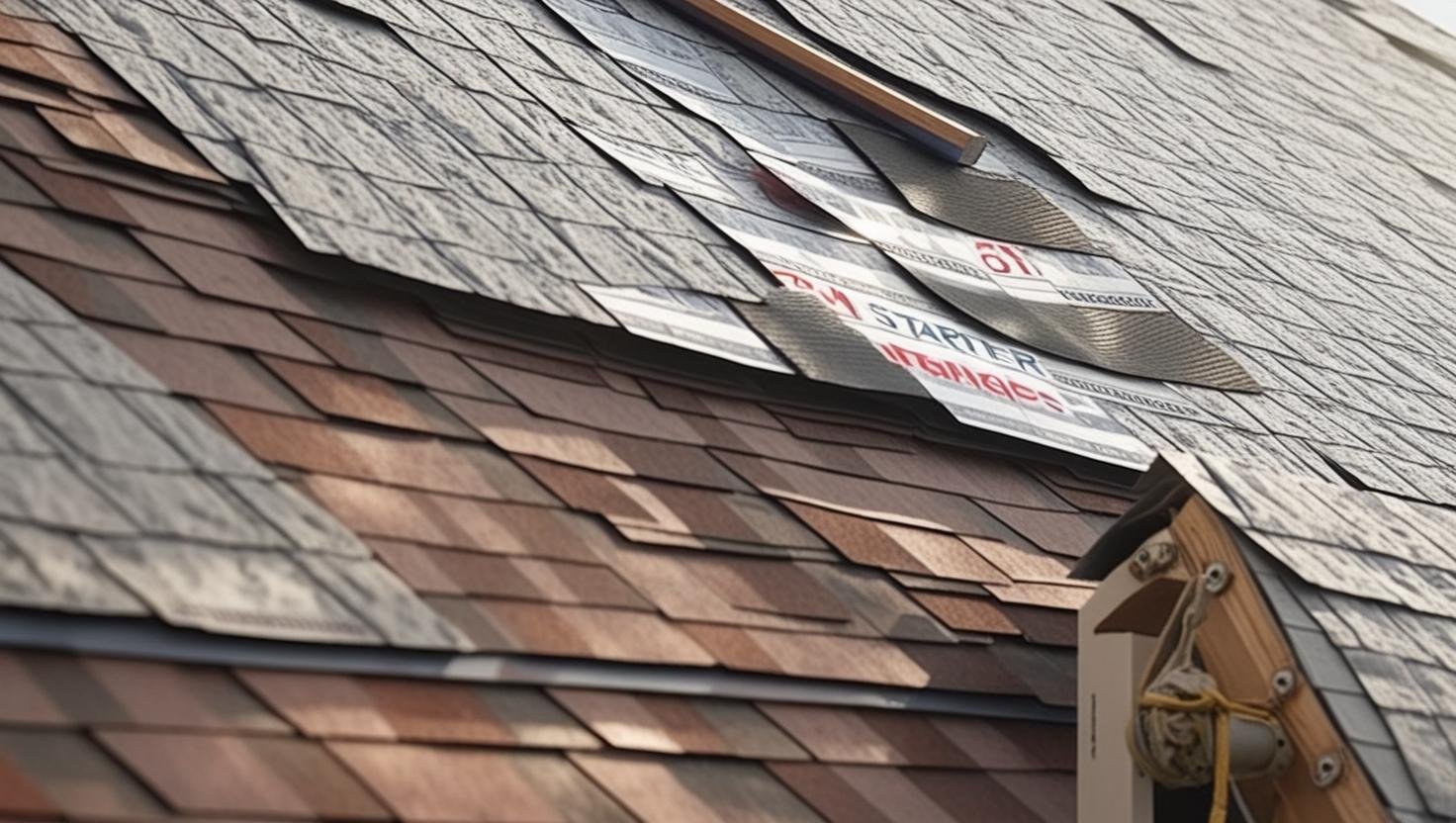Why Starter Shingles Matter: The Key to a Durable, Weather-Resistant Roof
Table of Contents
ToggleIntroduction
If you’re planning a new roof or replacing an old one, there’s one component you shouldn’t overlook—starter shingles. Often underestimated, these strips play a vital role in protecting your home from water damage, wind uplift, and poor alignment during installation.
While they might not be visible once your roof is finished, their function beneath the surface is absolutely critical. As the first line of defense at the roof’s edges, starter shingles create a sealed, secure foundation that supports everything built above them. Skipping them might seem like a cost-saving shortcut, but it can lead to leaks, shingle blow-offs, and costly repairs down the road.
From improving structural integrity to helping meet warranty requirements, understanding the purpose and proper placement of starter shingles can make all the difference in your roof’s performance—and your peace of mind.
What Are Starter Shingles?
Starter shingles are the first materials installed along the eaves and rake edges of an asphalt shingle roof. Typically made of fiberglass-reinforced asphalt, these uniform, rectangular strips include an adhesive edge that helps the first course of shingles adhere firmly in place.
Installed underneath the visible layer of shingles, they serve as a barrier against water and wind, keeping your roof secure from its weakest points outward. Because they’re designed to be compatible with most shingle styles, they simplify installation while reinforcing protection where it matters most.
Leading options like IKO’s Leading Edge Plus feature a perforated middle strip, giving you two starter strips per piece and making them efficient and economical for both professionals and homeowners.
Choosing the Right Starter Shingles for Your Roof
Not all starter shingles are created equal, and selecting the right product is key to maximizing performance, ensuring compatibility, and meeting warranty requirements. From material type to design, several factors influence which starter strip will work best for your roofing system.
- Match the Shingle Type
Starter shingles should complement the type of shingles used on the rest of the roof. Whether you’re using 3-tab, architectural, or designer shingles, the starter course must support the shape, thickness, and alignment of those shingles. Some manufacturers even design starter strips specifically for their premium lines, so it’s worth checking product specifications before buying. - Use Manufacturer-Approved Components
If you’re aiming for an enhanced warranty, it’s important to use a complete system from one brand. Starter shingles from GAF, CertainTeed, Owens Corning, or IKO are often required to be installed alongside matching shingles and underlayments. This ensures proper adhesion, coverage, and compliance with warranty terms. - Consider Regional Climate Conditions
In regions with high winds or frequent storms, choose starter shingles with strong adhesive bonding and a design tested for uplift resistance. In colder climates, look for products with cold-weather flexibility and high granule adhesion to avoid premature wear. - Rolls vs. Pre-Cut Strips
Starter shingles are available in rolls or pre-cut strips. Rolls offer greater flexibility and can be trimmed to fit, while pre-cut strips simplify installation and maintain consistent sizing. Some advanced models, like IKO’s Leading Edge Plus, even include perforations that provide two starter strips in one piece—offering both efficiency and accuracy. - Look Beyond Color
Starter shingles typically come in darker, neutral shades since they’re not visible once installed. Don’t worry about matching them to your finish shingles—they’re selected for performance, not appearance. Instead, focus on sealant quality, durability, and ease of installation.
Choosing the right starter shingles sets the tone for the entire roof. With the proper product, your installation will be smoother, the protection stronger, and the overall system more reliable for years to come.
Why Are Starter Shingles Important?
From a performance standpoint, starter shingles are non-negotiable. They seal off vulnerable areas like the eaves and rake edges, where wind-driven rain and snow are most likely to enter. Their self-sealing adhesive holds down the first course of shingles, reducing the risk of blow-offs during storms or high winds.
Beyond protection, they also guide the layout of the shingles that follow. That means straighter rows, fewer alignment issues, and a more polished overall look. Regardless of the shingle type—3-tab, architectural, or premium styles—starter shingles help the system stay uniform and strong.
They’re also a must-have for warranty compliance. Many manufacturers won’t honor a warranty if their recommended starter products weren’t used during installation. That’s why skilled contractors never skip this step—starter shingles help ensure long-term durability and coverage.
Where Should Starter Shingles Be Installed?
Starter shingles should be applied along all the edges of your roof—especially the eaves and rake edges. These areas face the most exposure to the elements, making them prime entry points for moisture and wind.
Installed directly beneath the first course of shingles, these strips overlap joints and extend slightly beyond the edge of the roof to direct water into the gutter system. At the rakes, although not always required by local codes, including starter shingles significantly boosts wind resistance and adds to the overall structure.
Proper alignment is key. The adhesive strip should face upward and sit near the roof’s lowest edge so that heat from the sun can activate the seal. Nails must be driven into the roof deck—not just the underlayment—to ensure a secure and lasting bond.
How Do Starter Shingles Affect an Asphalt Roof’s Warranties?
If you’re looking for long-term protection, installing starter shingles the right way is essential for securing enhanced manufacturer warranties. Brands like GAF, IKO, and CertainTeed often require matching starter shingles and system accessories for their top-tier coverage.
When installed by certified professionals using approved materials, your roof may qualify for up to a 50-year non-prorated warranty. This can include full coverage for labor, materials, and disposal—even if the original contractor goes out of business.
Starter shingles can also increase your roof’s wind resistance rating from 110 mph to 130 mph, which is a huge advantage in storm-prone areas. Skipping this step can disqualify your claim in case of failure, especially if it results from improper installation or missing components.

Common Mistakes to Avoid with Starter Shingles
Even with the best materials on hand, improper installation or planning can reduce the effectiveness of starter shingles. Based on real-world roofing experience, here are some common mistakes to avoid:
- Skipping Starter Shingles Altogether
One of the most frequent and costly errors is omitting starter shingles entirely. Some installers try to use regular shingles flipped upside down as a substitute. While this might seem like a shortcut, it doesn’t provide the adhesive seal or consistent edge that proper starter strips offer—leaving your roof exposed to wind and water damage. - Installing Them in the Wrong Direction
Starter shingles must be aligned correctly, with the adhesive strip placed along the edge facing upward. Reversing this placement compromises the seal and can cause shingles to lift during storms or under heavy wind loads. - Misaligned Overhang or Inadequate Coverage
The starter strip should slightly overhang the edge of the roof—typically by about half an inch—to allow water to drip off into the gutter system rather than soaking into fascia boards or the roof deck. Poor alignment leads to water infiltration and weakens the overall system. - Incorrect Nailing
Fasteners should penetrate through the roofing deck, not just the underlayment. Using too few nails—or placing them in the wrong location—can lead to shifting, lifting, or failure of the starter strip during high winds. - Mixing Incompatible Materials
Using starter shingles from a different manufacturer than the primary shingles may lead to compatibility issues. Many warranties require a complete system from the same brand to qualify for enhanced coverage, so mixing materials can void your warranty.
Avoiding these mistakes ensures your starter shingles perform as intended—protecting your home, supporting the rest of your roofing system, and maximizing the return on your roofing investment.
How Much Do Starter Shingles Add to a New Roof’s Cost?
Starter shingles are a small investment with big benefits. On average, they cost between $0.50 and $2 per linear foot, or $30–$90 per bundle, depending on the brand and material type. Pricing can vary based on region, contractor, and roof size.
Even with labor costs factored in, they make up only a small fraction of total roof installation expenses. According to This Old House, full roofing costs typically range from $4.50 to $12.25 per square foot, so the additional cost of starter shingles is minimal in comparison.
What they provide, however, is far greater than their price tag: moisture protection, better roof alignment, reduced long-term maintenance, and warranty eligibility—making them a smart, long-lasting investment.
Benefits of Starter Shingles
- Creates a watertight seal at eaves and rake edges
- Enhances wind resistance to prevent shingle blow-off
- Ensures a straight, clean edge for professional appearance
- Speeds up shingle alignment and installation
- Reinforces the first row of shingles for structural support
- Satisfies manufacturer warranty requirements
- Conceals under roof shingles with a seamless finish
- Offered in rolls or strips to fit various roofing systems
- Offers high value for minimal added cost
- Increases roof lifespan by securing vulnerable areas
Conclusion
While often hidden beneath the surface, starter shingles are one of the most important parts of your roofing system. They seal out moisture, hold shingles firmly in place, guide installation, and help ensure that warranties remain valid.
Whether you’re hiring a contractor or just exploring your roofing options, don’t overlook these essential components. When used properly and installed by a professional, starter shingles help your roof perform better, last longer, and protect your home in every season.
What Are Starter Shingles: (FAQs)
1. Are starter shingles absolutely necessary, or can I skip them?
Yes, starter shingles are necessary. Skipping them can lead to serious issues like water leaks, wind damage, and warranty voids. They create the first waterproof seal at the roof’s edge and help keep the rest of the shingles properly aligned and secured. Trying to substitute regular shingles or skipping them altogether is not recommended.
2. Can I use any brand of starter shingles with my roof shingles?
For the best results—and to maintain warranty coverage—it’s important to use starter shingles from the same manufacturer as your main roof shingles. Mixing brands may cause compatibility issues and could invalidate enhanced warranties. Always check the manufacturer’s roofing system guidelines before installation.
3. Do starter shingles go on both the eaves and rake edges?
Yes, starter shingles should be installed on both the eaves and rake edges of the roof. While code requirements may only mention eaves, adding them to the rakes improves wind resistance, reduces blow-off risk, and enhances the overall durability of your roofing system.
4. How do I know if my contractor used starter shingles?
Ask your contractor directly and request product documentation or photos during installation. Reputable contractors will include starter shingles in their material list and should have no issue showing you where and how they were installed—especially along the eaves and rakes.
5. Will starter shingles add a lot to my roof replacement cost?
Not at all. Starter shingles are a low-cost, high-value addition. They typically add a small amount—usually between $30 to $90 per bundle—to your roofing materials but can save you far more in the long run by preventing water damage and ensuring warranty protection.



